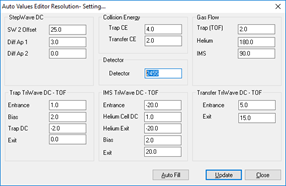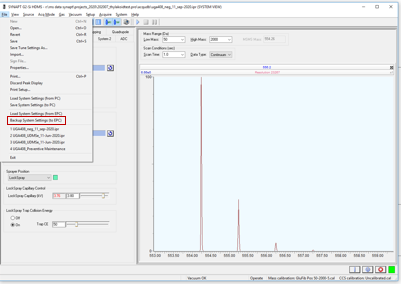Detector setup fails with beam error - WKB12269
SYMPTOMS
- "Beam error - too many beam intensity failures" or "Beam error - beam too weak" error occurs during detector voltage setup
- Problem arises even when the beam for LeuEnk is stable
- Cannot improve beam intensity sufficiently with higher flow rate or sensitivity
- Abnormal isotopic pattern for Leu Enk (incorrect relative intensity for 2nd and 3rd isotope peaks or artefact peaks are present in between isotopes)
- 2nd C13 isotopes (M+2) not visible
ENVIRONMENT
- Xevo G2
- Xevo G2-S
- Xevo G2-XS
- Xevo G3
- Synapt G2
- Synapt G2-S
- Synapt G2-Si
- Synapt XS
CAUSE
Problem is related to excessively high or low detector voltage at the beginning of the detector setup.
FIX or WORKAROUND
- In the Tune page, go to the Setup drop-down menu and select System View
- Enter the password: access
- Go to the System drop-down menu (not the system 1 or system 2 tabs)
- Select Auto Values and adjust the detector voltage in Resolution Mode manually

- If the signal is too high and shows artefact peaks after the real ones, decrease the detector voltage to remove artefacts but ensure LeuEnk is still giving a strong signal.
- If the signal is too low and the isotopic pattern of Leu Enk is abnormal, increase the detector voltage to reach signal in mid e5

- Click Update and Close.
- Save Tune Page with system Settings an backup to EPC

- Run Detector Setup.
- Repeat for Negative Ion mode, if necessary and backup the system settings to EPC once more to save the optimal values
ADDITIONAL INFORMATION
Make sure that the beam is stable (too high desolvation temp. and gas flows can cause an unstable beam)
Nominal mass position should be adjusted as needed
Capillary voltage should not be too high as this may cause overloading of the detector
Rapid changes in detector gain are typically seen with new detectors or when the instrument has recently been switched back on after several months of inactivity.
The first step of the detector setup algorithm is to drop the voltage down 25V to ensure the voltage isn't already set too high. But when systems have not had detector setup or check run in a long time, that 25V drop can effectively kill the beam. A 2e5 signal can drop to nothing, leading to confusion at an intensity error with 2e5 signal. In this case, adding voltage to the system manually will allow the drop to maintain signal.
Since the isotope distribution is critical to optimal detection, LeuEnk is the only compound that can be used for detector setup. LeuEnk has 28 Carbon atoms in it. The natural abundance of C12 to C13 is 98.9% to 1.1% respectively. So the probability of having a single 13C atom in the molecule is: 28 x 0.011 = 0.308 (30.8%). This is why the second peak must be ~30% to ensure proper setup.
id12269, MALDIG2SI, SYNAPTXS, SYNG2HD, SYNG2HDMAL, SYNG2MS, SYNG2MSMAL, SYNG2SHD, SYNG2SHDML, SYNG2SIHD, SYNG2SIMS, SYNG2SMS, SYNG2SMSML, XEVOG2QTOF, XEVOG2SQTF, XEVOG2STOF, XEVOG2TOF, XEVOG2XSTF, XEVOG3QTOF

